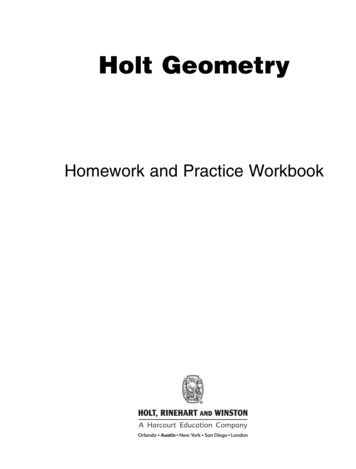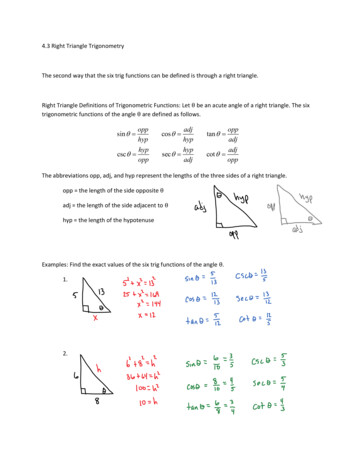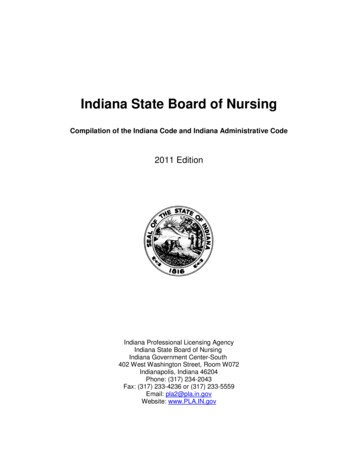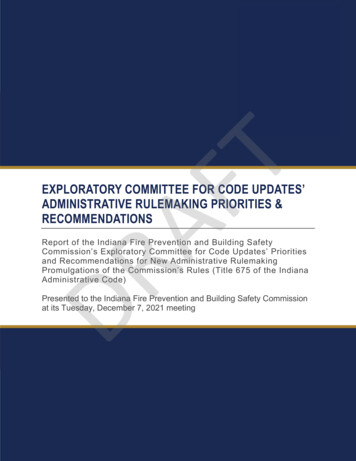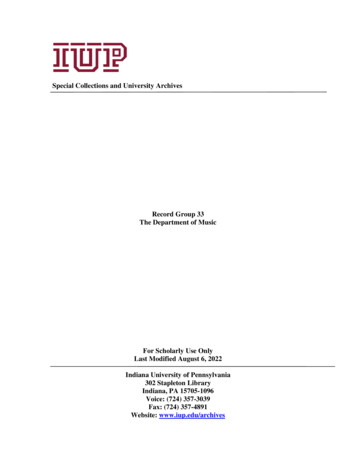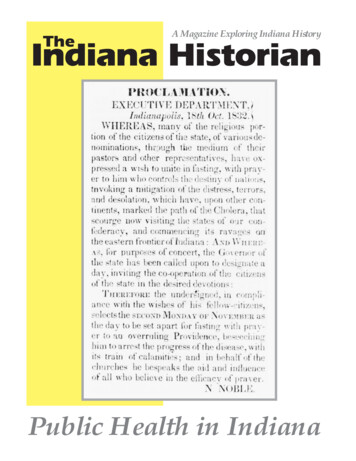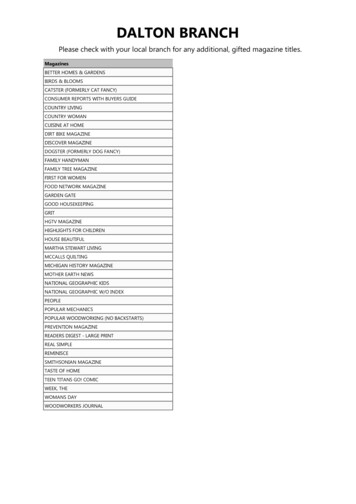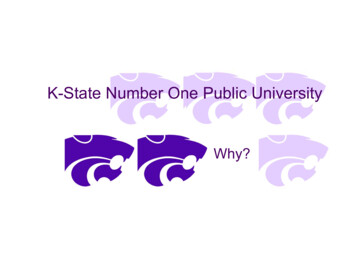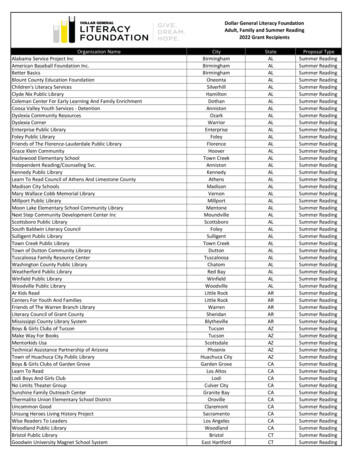
Transcription
I N D I A N AW E S L E YA NSummer 2007Ron MazellanIWU Professor Illustrates Book forBaseball Legend Cal Ripken, Jr.page 4U N I V E R S I T Y
DR. HENRY SMITHP R E S I D E N T O F I N D I A N A W E S L E YA N U N I V E R S I T YIWU Education a Great Value in Every RespectI am absolutely convinced that an education from Indiana Wesleyan University is oneof the best values in higher education today! IWU has world class faculty and facilities –both on our Marion campus and at our 14 regional sites – and, we compare veryfavorably with some of the finest universities in the land. For 2007, the U.S. News andWorld Report has listed IWU as one of the Best Master’s Universities in the Midwest.This issue of the Triangle illustrates IWU’s wide diversity and sphere of influence.With a total enrollment of over 14,000 students in Indiana, Ohio and Kentucky, and aMarion campus enrollment that for the first time this fall should exceed 3,000 students,clearly IWU is no longer a monolithic, single purpose, residential campus of modestenrollments. As the first students from our doctoral program in leadership graduated inAugust, we were reminded that we are a University in the truest sense.In this Triangle, stellar faculty are showcased representing IWU at our very best – anartist whose illustrations have achieved New York Times’ Best Sellers standing, a scholarwho has received national recognition for his studies of payday lending, and a professorwho just published a book on gambling addiction research. Ron Mazellan, Tom Lehmanand Tim Steenbergh represent three of our faculty who exemplify excellence in highereducation. The December Triangle will have stories focusing on research in NaturalSciences at IWU – Burt Webb (breast cancer), Dan Jones (osteoporosis), John Lakanen(anti-malarial drugs) and Matthew Kreitzer (retinal research).Also, you will read of the influence of our students, who as part of a growing cadre ofstudents, found the IWU programs for working adults to be just what they needed tosucceed. From Indiana’s Lieutenant Governor Becky Skillman, to Michael Smithson, anentrepreneur whose venture is a truck car wash – our graduates can be found nearlyeverywhere you look. Of the 31 independent colleges in Indiana, IWU ranks first in totalenrollment, ranks fourth in the total number of alumni, and ranks first in the most alumniresiding in Indiana.Two of our heroes of the faith, Howard Noggle and Arthur Hodson, left us for a betterworld this summer. But, I am encouraged that others have stepped in the gap ready totake their place. Todd Voss, our newly appointed Executive Vice President, and MichaelMoffitt, our new Vice President for Student Development, along with many other facultyand staff (20 new faculty just in the College of Arts and Science) are answering the call.For the coming year we have selected the scripture from Jeremiah 29:11 “For I knowthe plans I have for you,” declares the Lord, “Plans to prosper you and not to harm you,plans to give you hope and a future.” Pray for the more than 800 faculty, staff andadministration at Indiana Wesleyan University who are passionately committed tochanging our world through Christian higher education!M I S S I O N S TAT E M E N TIndiana Wesleyan University is aChrist-centered academic communitycommitted to changing the world bydeveloping students in character,scholarship and leadership.
F E AT U R EA R T I C L E SIWU Economist ExploresPayday-Lending Market6Dr. Tom Lehman has become one ofthe nation’s leading authorities on therapidly growing payday lendingindustry.Professor Hooked onGambling ResearchDr. Tim Steenburgh’s choice of a8graduate school opened unexpecteddoors that led to his ongoing researchinto gambling addiction.From a ClassroomTo the State House12Becky Skillman was working towardan IWU degree when a phone callbegan a journey to her current job asIndiana Lieutenant Governor.In MemoriamIWU’s beloved Dr. Howard Noggle,20F E AT U R EON THE COVER:S E C T I O N Swho first came to campus as a studentin 1936 and remained on the payrolluntil 2004, died at 88.Chaparral19Campus News21Job Openings25Alumni News26IWU Art Professor Ron Mazellan did the illustrations for a New York Times best-selling children’s book written by Baseball Hall of Fame inductee Cal Ripken Jr.INDIANA WESLEYAN UNIVERSITY TRIANGLE Summer 2007, Vol. 87, No. 4 EDITOR Alan Miller A RT DIRECTOR Gary Phillips ‘92 GRAPHIC DESIGNER Susan Spiegel ‘99ALUMNI NEWS EDITOR Krista Brown ‘05. The TRIANGLE (issn 10666893) is published quarterly, free to alumni, by Indiana Wesleyan University. Second-class postage paid at Marion, Indiana,and additional offices. POSTMASTER: Send address changes to Indiana Wesleyan University, 4201 South Washington Street, Marion, Indiana 46953-4974. Internet address: http://www.indwes.edu
Maz ellan& Ripk enOn New York T imes’Best Sellers ListIWU Professor and Baseball LegendHit Home Run with Children’s BookRRon Mazellan illustrated a children’s book written by Cal Ripken, Jr.“.I knew enough to know thatCal Ripken, Jr. was a famousbaseball player.”4S U M M E R2 0 0 7T R I A N G L Eon Mazellan came up with a quick answer when hisagent called in early 2005 with this simple question:“Are you a baseball fan?”Mr. Mazellan’s response: “Well, I can be.”Thus began one of the most hectic times in Mr.Mazellan’s career as he raced to complete illustrations for achildren’s book written by baseball legend – and now Hallof Fame inductee – Cal Ripken, Jr.“Baseball is not my sport, in particular, but I knew enoughto know that Cal Ripken, Jr. was a famous baseball player,”Mr. Mazellan said. “I also knew, as with any book, that Iwould have to do a lot of research. I couldn’t go on mylimited knowledge.”Mr. Mazellan has been a graphic designer and commercialillustrator for 20-plus years. Since 1993, he has taught art atIndiana Wesleyan University.The Longest Season (Philomel Books, 2007, 16.99),chronicles the lowest point of Mr. Ripken’s baseball life: theBaltimore Orioles’ 1988 season, which began with a recordshattering 21 consecutive losses.“Even though the story takes place in 1988, there was notas much accessible information as I would have liked,” Mr.Mazellan said. “I relied somewhat on copies of old SportsIllustrated magazines.”Mr. Mazellan had limited access to Mr. Ripken, which iscommon. Authors and illustrators never communicate witheach other directly, he said.“The publisher made it imperative that I was not to bugCal Ripken or others,” Mr. Mazellan said. “If I neededsomething from him, I was to package it in terms of what Ineeded specifically – and to make my requests as infrequentas possible.
“The publisher wanted to make it a very smooth book, notsomething where I had to get interviews with Cal Ripken.Basically, my instructions were, ‘This is your baby.’”Mr. Mazellan’s assignment: 18 illustrations. His timetable:six months. His reward: A bonus for getting everything doneon time.“When I told my wife, Jil, how much the bonus was, shesaid, ‘Oh, you’ll make the deadline.’ That was the thing thatreally held me. Once I have people, such as Jil, who arehonest with me, I know I’m in the right place – even if it’sgoing to be hard,” he said.The pressure, as Mr. Mazellan had expected, was intense.“It’s not that I love this kind of pressure, but the experienceI have with God is so unlike anything else,” he said. “It’s theone reason I favor stressful situations. It forces dependenceupon God, which is the way I should normally workanyway.”Mr. Mazellan also depends heavily on two of his IWUcolleagues, Rob Curfman, Chairperson of the Division of Art,and Rod Crossman, Artist-in-Residence.“If I did not have the support of Rob and Rod, and mywife, I could not keep my head on straight,” Mr. Mazellansaid. “They all are truthfully objective. When they say, intheir candid way, ‘That looks good,’ then I know I’ve hit it.”The final judge, of course, was Cal Ripken, Jr.“The book was finished at the end of 2005, but it sat for ayear so the publisher could do any final tweaking that wasnecessary,” Mr. Mazellan said. “The day that Cal Ripkencame in to approve the book, he was in New York, and I wasin Indiana, but I was on the edge of my seat.”Mr. Ripken’s only concern was the cover, which iscritically important when it comes to marketing the book, Mr.Mazellan said.“I submitted two paintings for the cover, both of whichwere rejected,” he says. “The publisher liked a pose insidethe book, which the publisher thought showed rejection andhow Cal Ripken was feeling that season.”The painting wound up on the front and back covers – aswell as inside the book.The Longest Season was released in April, to coincide withMr. Ripken’s July 29 induction into the National BaseballHall of Fame and Museum in Cooperstown, New York.Mr. Mazellan was doing graduate work in Connecticut atthe time and was not able to attend the Hall of Fameceremony.Shortly after its release, the book was No. 10 on the NewYork Times’ Best Sellers list of children’s picture books.“People ask me if I have met Cal Ripken or talked withhim, and I tell them it is not an objective for that to happen,”Mr. Mazellan said. “This is a business situation, and I’mtrying to make sure this story is everything he imagined.“I want it to be as good as he wants it to be. But, becauseof my standards, I want it to be even better than that. If CalRipken likes what I did, and it represents his story well, I amsatisfied. I do not have to meet him or have a personalrelationship with him.”I N D I A N AW E S L E Y A NU N I V E R S I T YCritics Review‘The Longest Season’“(Ron) Mazellan’s color-drenchedillustrations capture the emotionalintensity of the narrative.”—School Library Journal“(Ron) Mazellan’s illustrations depictthe events as seen from the dugout,conveying the player’s emotions withcloser-up focus on their stances andbody language. This one is a winner.”—Kirkus Reviews“(Ron) Mazellan’s watercolors emit theburnished glow of yesteryear.—Publishers Weekly“This book is dramatically illustrated.”—USA TodayOther Books Illustrated byRon MazellanThe HarmonicaWritten by Tony JohnstonReleased February 2004Finding Daddy: A Story of theGreat DepressionBuscando a Papa: Un cuentosobre la epoca de la GranDepresionWritten by Jo Harper andJosephine HarperReleased April 2005There Come a SoldierWritten by Peggy MercerReleased August 20075
6S U M M E R2 0 0 7T R I A N G L EDr. Tom Lehman has received national attention for his studies of the payday-lending industry.
Professor Sees Both Sides ofPayday-LendingMark et“I believe, on balance, that the payday-lending industryis serving a specialized market niche.”Dr. Tom Lehman came across an article about paydaylending while he was doing research in urbaneconomics and urban development for his doctoralthesis at the University of Louisville.“I took an immediate interest in how markets serve whatyou call working-class or poor clientele,” said Dr. Lehman,who received his doctorate in 2004. “Little research hadbeen done about the payday-lending market, so I decided tolook into it further.”Over the past few years, he has become one of thenation’s leading authorities on the rapidly growing business.Dr. Lehman, an Associate Professor of Economics, hastaught at Indiana Wesleyan University since 1997. Heearned a bachelor’s degree in 1992 from IWU and amaster’s degree in 1993 from Ball State University.When Dr. Lehman began studying the payday-lendingindustry, there was little previous research – and most of itportrayed payday lending negatively.“All you saw in the early literature was that these thingsare bad. We have to stop them. They should be outlawed,”he said. “I wanted to bring another perspective. I wanted todescribe what may happen to people in credit-constrainedsituations if we eliminate this option.”His conclusion?“I believe, on balance, that the payday-lending industry isserving a specialized market niche that, if it were removed,would leave people who depend on it worse off,” Dr.Lehman said. “It would drive that type of lending backunderground or drive people back into pawn shops.“For some people, it is not always a matter of having the‘best’ option. Sometimes it involves choosing the leastnegative option. Poor people deal with these kinds oftradeoffs every day of their lives,” he said.Dr. Lehman’s original argument defending payday-lendingpractices was published in 2003 in an economicdevelopment periodical – and immediately caught theattention of payday-lending institutions.The non-profit Consumer Credit Research Foundation hassupported ongoing research by Dr. Lehman and others. Thefoundation’s mission is to improve research and data alongI N D I A N AW E S L E Y A NU N I V E R S I T Ywith public discourse on the availability of short-termconsumer credit.“The first article that was published in defense of paydaylending set off a whole firestorm of responses,” Dr. Lehmansaid. “People who were doing research on payday lendingstarted calling me to get the other side of the story.“I did interviews and a webcast for a consumer group thatserves as a watchdog for the payday-lending industryEveryone wanted to know what I thought was good aboutthe industry.”Dr. Lehman emphasizes that he is not an apologist for thepayday-lending industry, nor does he wish to be. “Theindustry sees me as kind of an ally because I’ve shown bothsides of the business, but what they really want from me isthird-party objective research.”Some of Dr. Lehman’s research has been used to shapepublic policy. “Our research is heavily cited in statelegislatures that are debating, in effect, whether the paydaylending industry should be regulated out of business,” hesaid.“I hope some of the research I have done independently,and with the Consumer Credit Research Foundation, willconvince legislatures that laws they are considering mightdo more damage than good,” Dr. Lehman said.One of Dr. Lehman’s more recent studies contrastedinterest on payday loans to bounced-check fees.“Research shows that sometimes people write bad checksbecause they are desperate and have no place else to turn,”Dr. Lehman said. “They have to have prescription drugs fortheir kids, or they need to get their car repaired so they cango to work.“Often, the fees they have to pay for bouncing a check arethe same – or even more exorbitant – than the interestcharged on a payday loan.”Despite a nationwide boom in payday lending in recentyears, Dr. Lehman is among a small band of people doingresearch on the industry. He currently is gathering data for astudy of what factors influence where payday-lending storesare located.7
Gambling BoomShaped Steenbergh’s Doctoral Work“It is interesting, as a Christian, howyou understand gambling.”When Dr. Tim Steenbergh began his doctoral workat the University of Memphis, he neveranticipated that his studies would be shaped, atleast in part, by the growing popularity of legalizedgambling.Memphis is an hour north of Tunica, Mississippi, one ofthe poorest counties in America. When Tunica Countybrought in casinos to bolster its economy, the University ofMemphis clinic began getting referrals of problem gamblers.“My program was in clinical psychology and was researchfocused. I try to provide treatments that are based on whatresearch shows is truly effective,” said Dr. Steenbergh, anAssociate Professor of Psychology at Indiana WesleyanUniversity since 2003.What Dr. Steenbergh and his colleagues would discover isthat little research had been done about gambling addiction.“This was back in the mid-1990s when gamblingopportunities were really growing and people wereconcerned about problem gamblers,” he said. “I had aninterest in addictions anyway, so I decided to look furtherinto gambling issues.”Dr. Steenbergh began by developing paper-and-pencilinstruments in an effort to better understand the gamblingproblem. He attempted to measure the thought processes ofproblem gamblers and their abilities to manage theirproblems.“From there, we opened a treatment clinic and developeda treatment program at the University of Memphis,” he said.“Another graduate student, two faculty members and I got itup and running.“It was a great experience to build from the ground aclinic that provided treatment to the community and alsoallowed us to better understand the problem – and,hopefully, how to treat it,” Dr. Steenbergh said.He then went from the practical to the theoretical by8S U M M E R2 0 0 7T R I A N G L Ewriting both his master’s thesis and doctoral dissertation ongambling-related issues.After completing his doctoral work in Memphis, Dr.Steenbergh did a one-year internship – required for hisclinical degree – at the Cleveland (Ohio) VA MedicalCenter. He then did two years of post-doctoral training atMichigan State University.“My Michigan State training was interesting because itwas a health psychology position,” Dr. Steenbergh said. “Iwas seeing clients in a community hospital and also trainingresident physicians and medical students in terms of basicinterviewing skills.“Basically, I was teaching doctors how to ask goodquestions and how to understand the psychological aspectsof their patients. Doctors tend to ask closed-end questionsand focus on medical issues.“If you don’t really give patients an opportunity todescribe what’s going on, it’s hard to make the rightdiagnosis. And if physicians fail to understand thepsychological issues their patients face, then they willcontinue to suffer,” he said.Dr. Steenbergh has continued his gambling researchthroughout a professional journey that has come full circleto IWU, where he earned his B.S. degree in psychology in1993. Dr. Steenbergh has a master’s degree from Ball StateUniversity.“It is interesting, as a Christian, how you understandgambling,” he said. “There is a sector of the Christiancommunity that sees it as entertainment, even though itdoesn’t seem like a very enticing form of entertainment tome. For me, it’s an issue of stewardship and motives.”Dr. Steenbergh said it has been a challenge to do researchin gambling at a Christian university that formally forbidsall forms of gambling. “I try to maintain a neutral stance inmy research,” he said. “I want to understand why people
Dr. Tim Steenbergh wants to understand why people gamble – some of them in destructive ways.gamble and why some gamble in destructive ways.”“Gambling is not all bad or all good in terms ofoutcomes. Most people gamble without problems. It is not ashighly addictive as some would suggest,” he said.For addicts, however, gambling is a complicated andserious issue.“In addictive behaviors, it is so crucial to understand thatthose who struggle with addictions are discounting futurebenefits for a potential short-term gain,” Dr. Steenberghsaid.“The interesting thing about gambling addictions is thatone more wager could, at least in the short run, solve yourfinancial problem, whereas one more drink or one morecigarette or one more toke of marijuana is not going to solveyour problems.“But for those with financial difficulties, gambling may beseen as the only solution. Losing money and spending moreto try to win it back becomes a vicious cycle. For somepeople, gambling starts out as a way to enjoy an evening,but then it begins to grow,” he said.I N D I A N AW E S L E Y A NU N I V E R S I T YDr. Steenbergh currently is doing research to determinewhat impact warning labels might have on gambling. Hebegan by acquiring lottery tickets from various states to seewhat kind of warning information, if any, is provided tobuyers.“I tried to get free tickets but finally had to ask friends inother states to buy the tickets and mail them to me,” he said.“I worried a little bit about how IWU would respond if oneof the tickets actually won the jackpot. As it turned out, wedidn’t have to deal with that problem.”Dr. Steenburgh and two psychology professors at theUniversity of Memphis recently have published a book titledProblem and Pathological Gambling. The book provides anoverview of problem and pathological gambling anddiscusses how to evaluate and treat it.“The book outlines assessment and treatment strategies wedeveloped when I was a graduate student at the Universityof Memphis,” he said. “Our purpose in writing the book wasto provide clinicians with a greater understanding of theproblem and effective ways to address it.”9
IWU Adds Master’s inAddictionsCounseling“Our Addictions Counseling program goesbeyond substance abuse.”Addictions Counseling is the latest concentration thathas been added to Indiana Wesleyan University’sgrowing graduate counseling program. Twenty-sevenstudents currently are enrolled in Marion and Indianapolis.Don P. Osborn is the director of the Addictions Counselingprogram, which began in January. Mr. Osborn has abachelor’s degree in Christian ministries and master’sdegrees in psychology and theology plus post-graduate workin marriage and family therapy and addictions.He is working on a doctorate in counselor education atIndiana State University. In Indiana, he also is licensed inmental health, marital and family therapy, and in clinicalsocial work.Mr. Osborn was a pastor in Terre Haute, Indiana, when hewas asked to work in a community mental health center. “Inever planned to get into addictions counseling, but theaddictions group needed a marriage and family therapist,” hesaid. “That was my doorway into addictions counseling.”Mr. Osborn already had done coursework in addictionscounseling and that, coupled with practical experience,qualified him to take – and pass – the Indiana and nationalexaminations to become a certified Master AddictionsCounselor.IWU’s new Addictions Counseling program will allowgraduates to take state and national certification exams – andan Indiana licensing exam, once one is approved by theLegislature.The program is an Approved Provider of the NationalAssociation of Alcohol and Drug Abuse Counselors(NAADAC) and the state affiliate, the Indiana Association ofAddiction Professionals (IAAP). Upon graduation, studentsare exam eligible.“Our Addictions Counseling program goes beyondsubstance abuse,” Mr. Osborn said. “It also will includesexual disorders, gambling and eating addictions. Themajority of the curriculum, however, will relate to chemicaldependency.”Forty-eight hours of coursework are required for the10S U M M E R2 0 0 7T R I A N G L EDon Osborn heads IWU’s Addictions Counseling program.Master of Arts degree in Addictions Counseling. Mr. Osbornsaid it would take about three years for most students tocomplete their degree.Students also may take an additional 15 hours ofcoursework to prepare for state licensure as a licensedmental health counselor.Mr. Osborn said students already enrolled in the programfall into three general categories: Counselors who already have master’s degrees butwant to pick up additional courses in addictionscounseling. “There are many people working in thearea of addictions counseling who do not havespecific training in that area,” Mr. Osborn said. Beginning students who want to earn a master’sdegree in addictions counseling. Students who already may be working toward amaster’s degree in another area of counseling butwant to add a second major in addictions counseling.The IWU graduate counseling program also offersmaster’s degrees in Marriage and Family Counseling,Community Counseling and School Counseling.Mr. Osborn is a past president of the Indiana affiliate ofNAADAC and currently serves as a regional vice president,with responsibility for similar associations in other states.“Addictions counseling is not something I planned to do,but that is what God had in mind for me,” Mr. Osborn said.
“Indiana Wesleyan’s adult educationp rogram was close to homeand was an ideal fit for me.”– Becky Skillman12S U M M E R2 0 0 7T R I A N G L E
‘T he Governor CallsMe the Q uarterback ’Beck y Sk illman Goes from IWU Classroom to Indiana StatehouseIn 2004, Lieutenant Governor Becky Skillman became afootnote in Indiana Wesleyan University history bybecoming the first IWU student to interrupt her collegeeducation to run for – and be elected to – the second highestoffice in the state. She is more than halfway throughcompleting her bachelor’s degree in business.Lieutenant Governor Skillman said it never occurred to herthat she could not – or should not – run for public office. Andwhat a run it has been.Lieutenant Governor Skillman was 26 when she waselected county recorder of Lawrence County, in southernIndiana. She went on to serve 16 years as an elected countyofficial and then 12 years in the Indiana Senate.Lieutenant Governor Skillman said her 32-year career inpublic service grew out of a special relationship she had withher grandfather. “My grandfather was my mentor,” she said.“He treated me as an adult from the time I was very young.He was such a disciplined, loyal Christian man, and Irespected him so much.”Lieutenant Governor Skillman said her grandfather also hada keen interest in government and politics.“Until he died in 1995, we were in constantcommunication,” she said. “He was always calling me todiscuss current events. He taught me that it was important tobe interested in your community, your state, your country andwhat was happening around the globe.”Lieutenant Governor Skillman never has lost an electionand never has had an opponent in a primary election.While she was serving as Lawrence County Clerk,Lieutenant Governor Skillman was elected president of theAssociation of Indiana Counties. One of her responsibilitieswas to lobby the Indiana Legislature on behalf of countygovernment.“The time I spent at the State House piqued my interest inrunning for a seat in the Indiana Senate,” she said. “I thoughtI could best represent people in south-central Indiana andbring some new ideas to the table.”Lieutenant Governor Skillman moved through the ranks tothe No. 2 leadership position in the Senate. It is that role, shebelieves, that caught the attention of Mitch Daniels, who hadannounced his candidacy for Indiana governor.“I had legislative experience. And, I am a Hoosier, born andbred in one of Indiana’s small towns,” Lieutenant GovernorSkillman said. “I understand the importance of economicdevelopment in all of our cities and towns, regardless of size.“The governor calls me the quarterback because I’ve beenassigned the task of running the legislative agenda when theLegislature is in session.”Governor Daniels is the first Indiana governor in recentI N D I A N AW E S L E Y A NU N I V E R S I T Yyears with no experience in the Legislature. He is a former EliLilly & Company executive and was Budget Director forPresident George W. Bush before coming home to run forgovernor.Lieutenant Governor Skillman is the first woman everelected to the state’s second-highest office. “I’ve never madegender an issue in any campaign but, of course, I am proud tobe the first woman elected as Indiana lieutenant governor.“I try to be very much aware that all of us in public serviceserve as role models for the next generation, and I do receivean extraordinary number of invitations from women’sbusiness groups and youth groups.”Lieutenant Governor Skillman said that few states have asmany responsibilities for their lieutenant governor as Indianadoes. Among her responsibilities are direct oversight ofagriculture, community and rural development, tourism,housing finance and homeland security. She also presidesover the state Senate.“A veteran legislator wrote to me during the campaign andsaid, ‘Whenever the Legislature has a great idea andlegislators don’t know what to do with it, they give it to thelieutenant governor.’ And I said, ‘I noticed that.’”One of Lieutenant Governor Skillman’s most difficult, butpoignant, assignments came as she stood at IndianapolisInternational Airport as the bodies of four fallen Hoosiersoldiers were returned home from Iraq.“Standing there holding the hands of those family membersand participating in that ceremony was one of my proudestmoments but, at the same time, one you must really disciplineyourself for,” she said. “But to see the families’ pride throughtheir tears made me so proud to be a Hoosier.“Although this has been nearly three years of action,change and progress, all of my most special memories duringmy first 30 months as lieutenant governor are about thepeople of Indiana, their strength, their courage, theircharacter,” she said.The Daniels-Skillman team already has announced itsintention to seek a second, four-year term in 2008. Beyondthat, Lieutenant Governor Skillman said she has given nothought to running for governor.One of Lieutenant Governor Skillman’s long-range goals,however, is to finish her college degree – probably at IndianaWesleyan University.“Indiana Wesleyan’s adult education program was close tohome and was an ideal fit for me,” she said. “I enjoyed theclassroom and became so close to all of the students thatbegan in our first class. I know many of them have sincecompleted their degrees, and I look forward to joining theirranks as an IWU alum.”13
IWU Grad Uses Faithto Help Offenders Mak e Better ChoicesDavid Liebel describes himself simply as “one ofthose people who took 20 years to get a bachelor’sdegree” – which he received in December 2002through Indiana Wesleyan University’s adult educationprogram.Mr. Liebel brought a world of experience with him toIWU and now has taken his classroom knowledge behindthe walls of Indiana’s prisons. He is the Assistant Directorfor Religious and Community Involvement for theDepartment of Correction.“I attended a private college in Indiana for two years rightout of high school before deciding, at least for the timebeing, that I didn’t have any good reason for being incollege,” Mr. Liebel said. “It was an expensive way to passthe time.”After working for a commercial photography business for10 years and experiencing a spiritual conversion, Mr. Liebelfelt a call into missions. He answered the call, spending fouryears in England with an inter
6543_Triangle.qx 8/8/07 1:12 PM Page 5. 6 SUMMER 2007 TRIANGLE Dr. Tom Lehman has received national attention for his studies of the payday-lending industry. 6543_Triangle.qx 8/8/07 1:12 PM Page 6. INDIANA WESLEYAN UNIVERSITY 7 D r. Tom Lehman came across an article about payday
